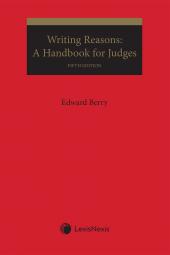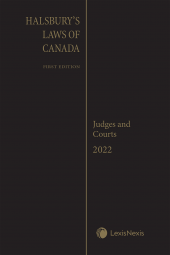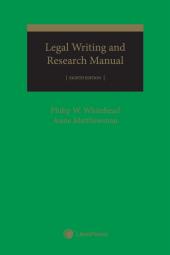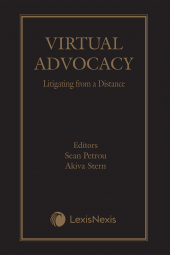Writing Reasons: A Handbook for Judges, 5th Edition
One Year Subscription Only Terms
Subscribers receive the product(s) listed on the Order Form and any Updates made available during the annual subscription period. Shipping and handling fees are not included in the annual price.
Subscribers are advised of the number of Updates that were made to the particular publication the prior year. The number of Updates may vary due to developments in the law and other publishing issues, but subscribers may use this as a rough estimate of future shipments. Subscribers may call Customer Support at 800-833-9844 for additional information.
Subscribers may cancel this subscription by: calling Customer Support at 800-833-9844; emailing customer.support@lexisnexis.com; or returning the invoice marked 'CANCEL'.
If subscribers cancel within 30 days after the product is ordered or received and return the product at their expense, then they will receive a full credit of the price for the annual subscription.
If subscribers cancel between 31 and 60 days after the invoice date and return the product at their expense, then they will receive a 5/6th credit of the price for the annual subscription. No credit will be given for cancellations more than 60 days after the invoice date. To receive any credit, subscriber must return all product(s) shipped during the year at their expense within the applicable cancellation period listed above.
Product description
"Writing Reasons deserves a wider audience. Administrative tribunal members are obvious candidates for that audience: from the point of view of sheer numbers alone, their decisions affect the day-to-day lives of many more people than decisions of courts, and Berry's advice transposes well to the writing of administrative decisions.
Berry also makes the case that judges who give mostly oral judgments can benefit from some of the ideas in the book, and provides advice specifically for them. Lawyers who diligently craft written submissions would also do well to imagine themselves in the judge's role and revise with that role in mind; Writing Reasons would be a good place to start.
Finally, law schools, which traditionally have focused on other forms of legal writing –research memos, opinion letters, factums, pleadings, and essays – might want to consider the benefits of teaching judgment writing. Using the third edition of Writing Reasons, I did that for the first two years in an upper-year seminar course on the written judgment – and I have recently continued the practice with the fourth edition of Berry's excellent book."
Reviewed by John C. Kleefeld (4th Edition)
Professor and Dean of Law, University of New Brunswick
See the review in McGill Law Journal – Revue de droit de McGill 63:1
To purchase the French version of the 5th Edition, please visit the Les Éditions Thémis website.
Writing Reasons: A Handbook for Judges, 5th Edition is a helpful guide for adjudicators on how to comprehensively structure and write judgments. Written by Edward Berry, an experienced lecturer and well-recognized seminar leader on the subject of writing judgments, this text is unique among works on legal writing in its focus on judgments, about which it offers guidance not only to adjudicators but to lawyers submitting written materials to the court.
This book is particularly useful as it provides:
- Practical content devoted to the art of effectively writing judgments
- Insightful commentary on structure, grammar and writing for your audience
- Tips for making writing both clear and personal
- A series of exercises designed to test your ability to put into practice the principles of judgment writing, as well as an Appendix containing suggested "answers" to these exercises
What's New In This Edition
- Significant revisions to Chapter 5: Words and Sentences, which extends and re-works material that had previously appeared in Chapters 6 and 7 of the previous edition
- Significant revisions to Chapter 1: Introductions, which includes new examples of organizational variety; Chapter 2: Organization, which expands the previous treatment of issue-driven structures; and Chapter 7: Widening the Audience, which adds new examples
- The reading list from the previous edition has been expanded and updated as Appendix 2: Additional Resources
Who Should Read This Book
- Judges and members of administrative tribunals who need a reliable resource that will help them write well-structured, clear and concise judgments
- Litigation lawyers who will find this guide essential to determining what judges and tribunals are looking for in pleadings and other court documents
- Law libraries that want to add this volume to their collection to assist lawyers, judges, students, legal writing professors and tribunal members
Table of contents
Preface
Prologue
Chapter 1: Introductions
Chapter 2: Organization
Chapter 3: Conciseness
Chapter 4: Organizing Paragraphs
Chapter 5: Words and Sentences
Chapter 6: Punctuation
Chapter 7: Widening the Audience
Chapter 8: Developing a Personal Style
Chapter 9: Revising
Appendix 1: Exercise Key
Appendix 2: Some Additional Resources
 Lexis Nexis
Lexis Nexis 


